General information on Maya & Merit’s tomb
Maya was Overseer of the Treasury and Overseer of Works during the reign of the boy-king Tutankhamun (1333-1323 B.C.). This made him responsible for Egypt’s home affairs at the unsettled time following the heresy of King Akhenaten, who had closed all the temples and only adored the sun god Aten. It was Maya who helped to re-establish the traditional cults and who fashioned new
statues for the numerous sanctuaries throughout Egypt, while his colleague, the General Horemheb, pacified the revolting foreign countries. At Tutankhamun’s death, Maya was responsible for the royal burial, which contained objects inscribed with his name. Then we lose track of Maya, but he was certainly back in office when Horemheb became the new pharaoh four years later. Maya seems to have died around year 9 of Horemheb’s reign (c. 1310 B.C.). His wife Merit had predeceased him and since the couple had two daughters only, the funeral was led by Maya’s half-brother Nahuher.
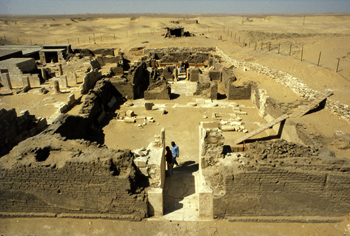
Overview of the Tomb of Maya as found
Superstructure of Maya & Merit’s tomb
Maya’s tomb was found in 1986 and excavated between 1987 and 1991. It lies parallel to Horemheb’s and Tia ‘s monuments and is almost 44 m long and 16.5 m wide. The plan is also similar to Horemheb’s and comprises a pylon , outer courtyard, statue chamber flanked by two storerooms, inner courtyard, and three offering chapels in the west. The tomb was obviously unfinished: the outer courtyard had columns along the west side only, a mud floor instead of proper pavement, and no reliefs. The pylon was built in mudbrick only, not revetted in limestone like Horemheb’s. Beautiful relief fragments in the pylon gateway, the entrance to the inner courtyard, and that courtyard itself depict offering bearers and portraits of the tomb owner and his relatives. Several reliefs were quarried by Coptic monks of the Monastery of Apa Jeremias (now in the Cairo Museum) or were taken by Lepsius and other 19th-century visitors. The three Leiden statues once stood on the bases still extant in the statue chamber and the outer courtyard.
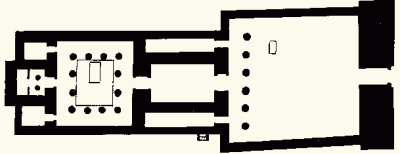
Map of the Tomb of Maya
Substructure of Maya & Merit’s tomb
Maya’s tomb-shaft opens in the inner courtyard and is about 10 m deep. From one of the six chambers at that level a second shaft and stairway give access to a lower complex, situated at a depth of almost 22 m. This comprises three chambers with beautiful wall-reliefs on limestone panelling, each with an undecorated annex. So far, such underground reliefs are unique in the Saqqara New Kingdom necropolis. They depict Maya and Merit adoring the gods of the hereafter. Both figures and texts are painted yellow, with some details in blue and black. The revetment had been smashed by robbers but could be fully reconstructed by the expedition in a new concrete basement under the outer courtyard. The robbers had taken most of the valuables, but numerous remaining fragments of coffins, furniture, jewellery etc. gave an impression of the riches of Maya’s burial. Both the substructure and the superstructure held the remains of hundreds of pottery vessels, often of highly unusual form and decoration. During the Late Period, the tomb and its surroundings were re-used for the accommodation of a number of poor multiple burials.
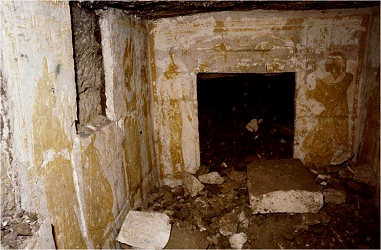
Substructure of Maya as found in 1986
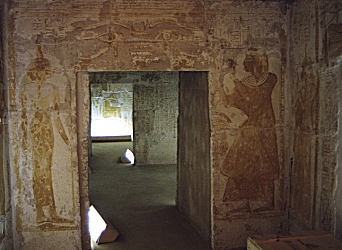
Restored substructure of Maya
Most interesting finds from Maya’s tomb
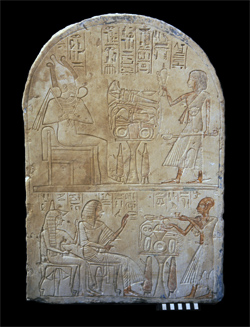 Stela of Yamen
Stela of Yamen
Two small chapels were discovered, built against the exterior face of the south wall of Maya’s tomb. One of these still held an offering table and a limestone stela. The latter is inscribed for a lector-priest called Yamen. Above, he is represented as offering to Osiris, while below he performs the same ritual for a seated couple: the overseer of the treasury of the lord of the Two Lands Maya and his wife Meryt. Clearly, Yamen functioned as funerary priest after the death of the tomb-owners. Maya and Meryt only had two daughters, no son who would usually have taken care of the funerary cult of his parents. Maya’s burial rites were led by his half-brother Nahuher, who is depicted several times in the reliefs. After the interment, he must have left the tomb in the care of a profesional priest, i.c. Yamen. The latter used the opportunity to erect a small shrine for himself.
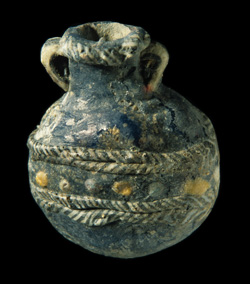
Glass bottle
This elegant glass bottle was discovered in the debris filling the outer courtyard of the tomb. It is shaped like a miniature pilgrim bottle, with a lentoid body, short and narrow neck with rolled rim, and two small loop handles. The dark blue body is decorated with brown-and-white spiral rods and yellow, pale blue, and white roundels.The body was moulded around a sand core dipped in molten glass, the decorations were applied while the body mass was still soft. Probably this bottle was produced in the glass factories at Medinet Ghurab, near the oasis of the Fayum, where similar items have been found. We may surmise that the bottle once held a costly perfume. Whether it belonged to Maya’s burial gifts is unfortunately not certain.
Maya’s Family Relations

Objects from Maya’s tomb in museum collections
- Baltimore, Walters Art Gallery 22.86: relief
- Berlin, Ägyptisches Museum, 2088: relief
- Berlin, Ägyptisches Museum 2089: relief
- Cairo, Egyptian Museum JE 43272: door jamb
- Cairo, Egyptian Museum JE 43273: door jamb
- Cairo, Egyptian Museum JE 43274: relief
- Cairo, Egyptian Museum T 19.6.24.1: relief
- Cairo, Egyptian Museum T 19.6.24.10: door jamb
- Cairo, Egyptian Museum T 19.6.24.13: relief
- Frankfurt, Liebieghaus St.P. 425: relief
- Hamburg, Museum für Kunst und Gewerbe 1924.123: relief
- Leiden, Rijksmuseum van Oudheden AST 1: statue
- Leiden, Rijksmuseum van Oudheden AST 2: statue
- Leiden, Rijksmuseum van Oudheden AST 3: statue
- Leiden, Rijksmuseum van Oudheden AP 55: pilaster
- Leiden, Rijksmuseum van Oudheden F 1993/8.1: relief
- Rochester (N.Y.), Memorial Art gallery 42.55: relief
- Toronto, Royal Ontario Museum 955.79.1: relief
Bibliography
Final report:
Martin, G.T., et al., The Tomb of Maya and Meryt, I: The reliefs, Inscriptions, and Commentary (London, 2012).
Raven, M.J., et al., The Tomb of Maya and Meryt, II: Objects and Skeletal Remains (Leiden/London, 2001).
Aston, D.A., and Aston, B.G., The Tomb of Maya and Meryt, III: The Pottery (in preparation).
[Plaatje Maya 1] [Plaatje Maya 2]
